Clean Water in Laos: The Sales Event of the Dry Season
June 1, 2015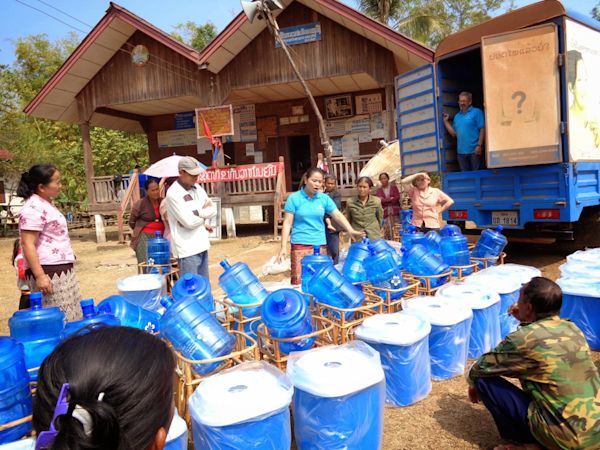
The first TerraClear sales event of the day starts early so the director and I are on the road at 6:30 AM this Tuesday morning. The goal is to get to the sales event an hour early to help the sales team set up. The sales team arrives even earlier to go door to door and personally invite the village residents to join the clean water discussion taking place later.
The official village leader, or headman, is the point of contact for the whole village. The sales team generally contacts him the night before an event to ask about the clean water status of the village. If TerraClear water filters would be a good fit and a welcome addition to their water supply, a meeting is scheduled for the following day. We're here this morning because we not only obtained permission to hold the meeting but also because there's no reliable ready-to-drink water supply; all natural water sources here must be boiled before consumption which is both time consuming and costly.
As is often the case, we will wait until the morning meeting at the wat, or Lao Buddhist temple, lets out. The extra time affords us the chance to explore the village and see where they currently draw their water. The first water supply I note is the river as we enter the village. As in most villages, it's used mostly for agriculture and household chores. Immediately in front of the headman's office, however, is a relatively new hand-pump well, the first improved water source I see.
A two-minute walk down the main village road and we come across this much older improved water source: a simple and shallow well covered with a piece of corrugated metal and a tub to collect the water.
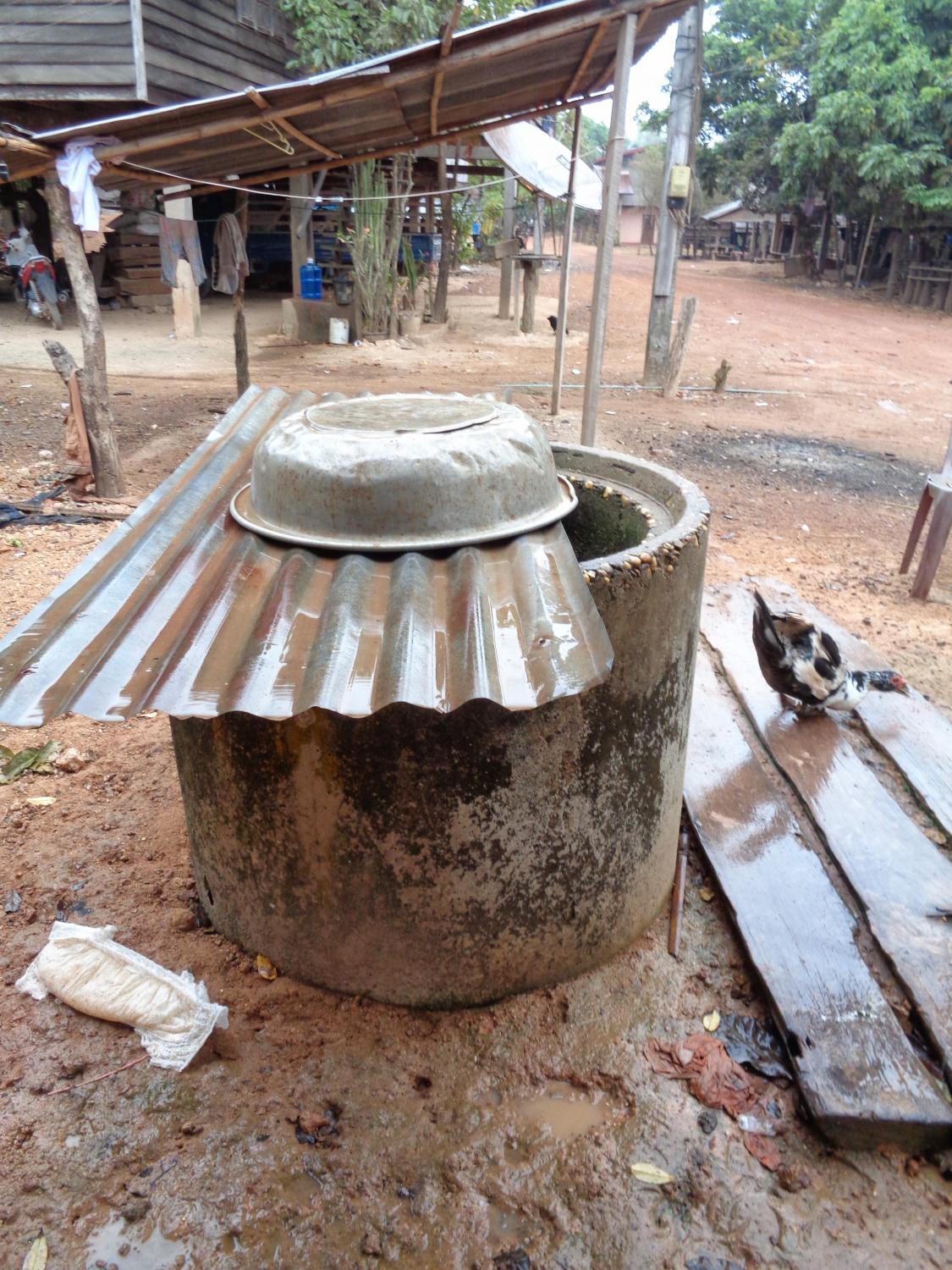 An "improved water source" in Khammouane Province, Lao PDR
An "improved water source" in Khammouane Province, Lao PDRTaking a look inside, I note that there are some small floating objects: a phone card, a candy wrapper and some leaves. The water is murky and the fact that I can see the shallow bottom seems strange. The soiled diaper at the external base of the well makes hard to imagine that this is much better than the river water 15 meters away. This was likely used much more before the hand pump was built.
At this point, we hear some ending announcements on the loudspeaker and start to see some villagers leaving the wat so we head back to the headman's office, the site of the sales event today.
People trickle in slowly, removing their sandals and shoes before climbing the steps of the headman's porch, our meeting locale. The headman gets on the loudspeaker to invite any remaining interested villagers to join us to discuss clean water.
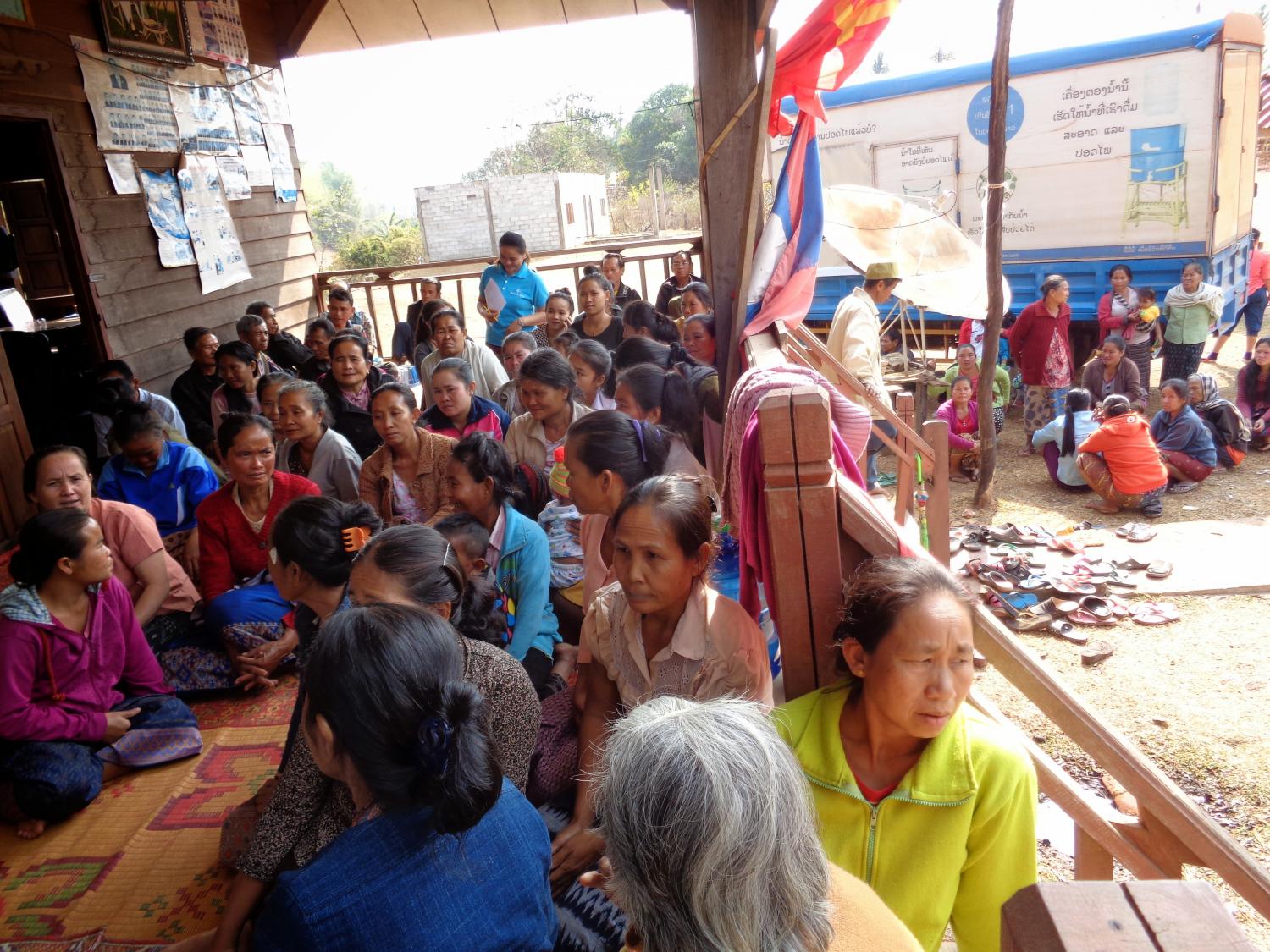 Villagers gather on the porch of the headman's office.
Villagers gather on the porch of the headman's office.First on the agenda are always sales team introductions. They, too, are foreigners in this village and they want to make sure everyone feels comfortable with them. After they've shared a bit about themselves, they introduce a brief overview of the TerraClear water filtration unit's parts and how it works.
To break the ice, people are asked to guess how much the ceramic filter weighs: 2, 3 or 4 kilograms? The team welcomes people to come forward to touch and hold it to get a better sense. All is takes is one intrigued audience member to step up and handle the ceramic filter and then many others to follow suit. They are encouraged to write their guesses on the back of their invitation slip to enter a prize drawing which will take place at the end of the meeting. People unable to write ask their neighbors to put down their guess and turn in their slip for them. The once placid crowd grows lively as they estimate the weight and talk amongst themselves.
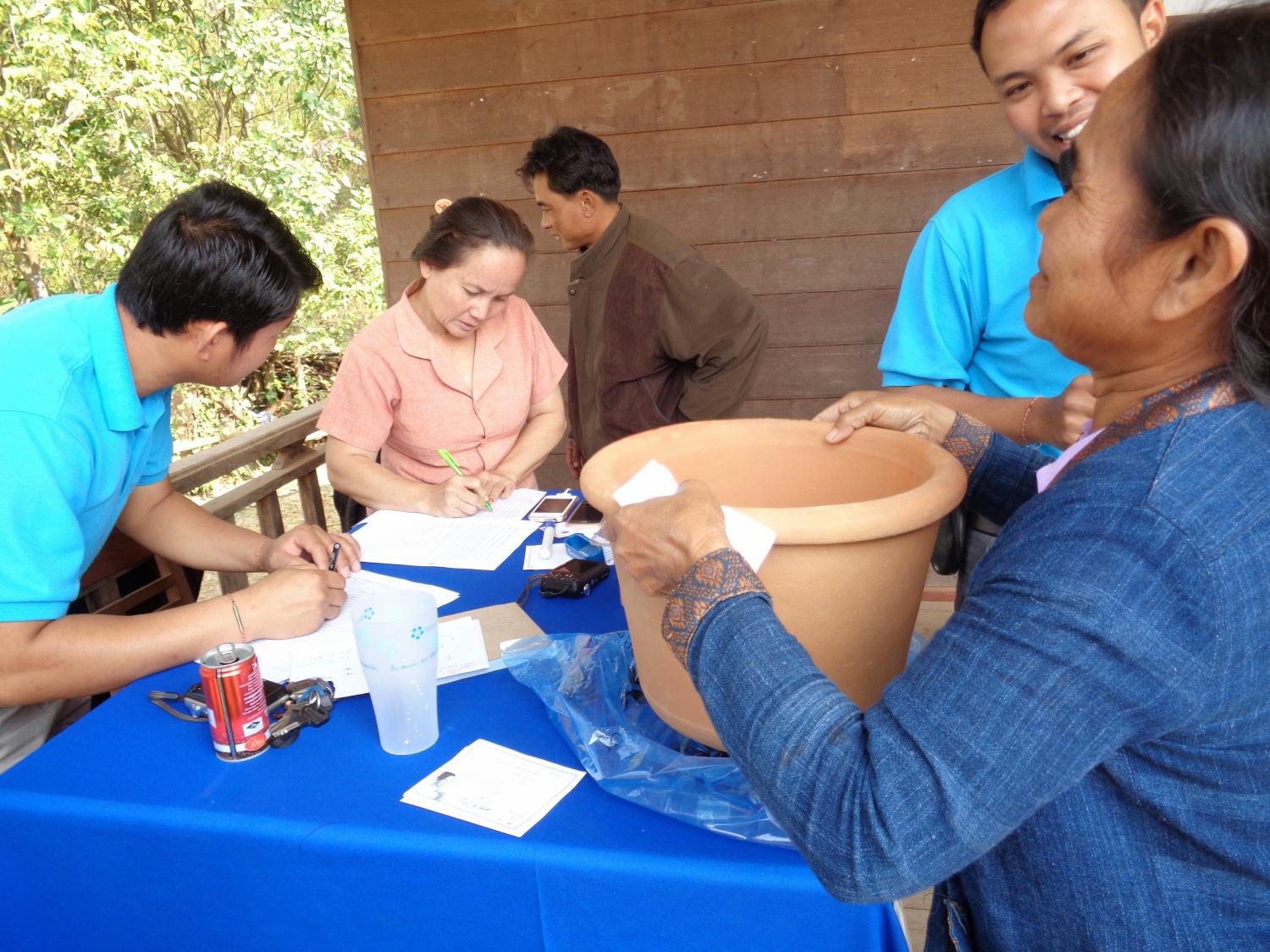 Villagers lift the ceramic filter to guess its weight and enter a prize drawing.
Villagers lift the ceramic filter to guess its weight and enter a prize drawing.Once everyone has had the chance to enter the drawing, the sales team gets down to business. First, the discussion leader asks about the types of water available in the village. Much of Southeast Asia gets their purified drinking water in 5 gallon jugs and this village has access to those, too. So, how much is one jug? What about if you buy them in bulk, is there any discount?
 The group discusses and visualizes the cost of purified water bottles, wood or coal to boil unsafe water and medicine for health issues that arise from dirty water.
The group discusses and visualizes the cost of purified water bottles, wood or coal to boil unsafe water and medicine for health issues that arise from dirty water.The leader then moves on to self-purification methods. Do you supplement your water supply with river or well water? Do you have to boil the water from those other sources? Do you then use coal or wood? How much does a bunch of wood cost? Is coal available in this village? How much is a bag of coal bricks?
From there, they ask about general water-related health issues. Do you or anyone in your family get sick from bad water? Many households are less eager to share these responses out of fear that they are the only ones dealing with dysentery or other water-borne bacteria. However, once the first voice rises up from the crowd to share their personal medical costs, many more chime in. Not only is there an immediate consensus that dirty water is bad for anyone's health, the villagers get to see that many of their neighbors are suffering from the same ailments. The stigma of water-borne illness is instantly reduced.
The most powerful part of the whole sales pitch is when all those costs are added up to calculate the total yearly cost of their current water system. For many families, this is the first time that they've seen or calculated how much they might spend in a year and many are surprised. Most Lao are subsistence farmers and therefore have little room for predicting their salaries or planning for future expenses.
Since a TerraClear water filter is guaranteed for two years, the village's total yearly cost is then multiplied by two for comparison to the TerraClear water filter.
When the villagers are confronted with their average yearly investment in the health of themselves and their families, suddenly the $70 cost of the TerraClear "Medium Set" (including the rattan stand, jug, tank and ceramic filter) is a much more economical investment.
By the end of the discussion, I know I am sold. I look around the meeting and see looks of understanding and interest on the faces of the villagers. But even when presented with such a strong case for purchasing the product, the decision may not be up to the family member who attended the meeting. And certainly the upfront cost of the unit is still too high for the vast majority of households. They mull it over. In the meantime, the weight of the ceramic filter is revealed and a winner with the correct guess is drawn. She stands up smiling from ear to ear and walks forward to receive her new plastic TerraClear drinking cups.
Only some households have signed up to purchase so far. When Kiva funding is offered to enable nine months of financing, the smiles spread throughout the audience. With clean water suddenly within reach, many rush home to get the 50,000 Lao kip deposit, the equivalent of about $6.50. As deposits return, one sales team member sits to write out receipts. The others begin to unload the units from the TerraClear truck.
 Kiva borrowers help unload the TerraClear truck.
Kiva borrowers help unload the TerraClear truck.As the units are set up, Kiva borrowers begin inspecting their choices. The rattan stand is or particular interest to many borrowers because it may be the only piece of furniture that they'll have in their home.
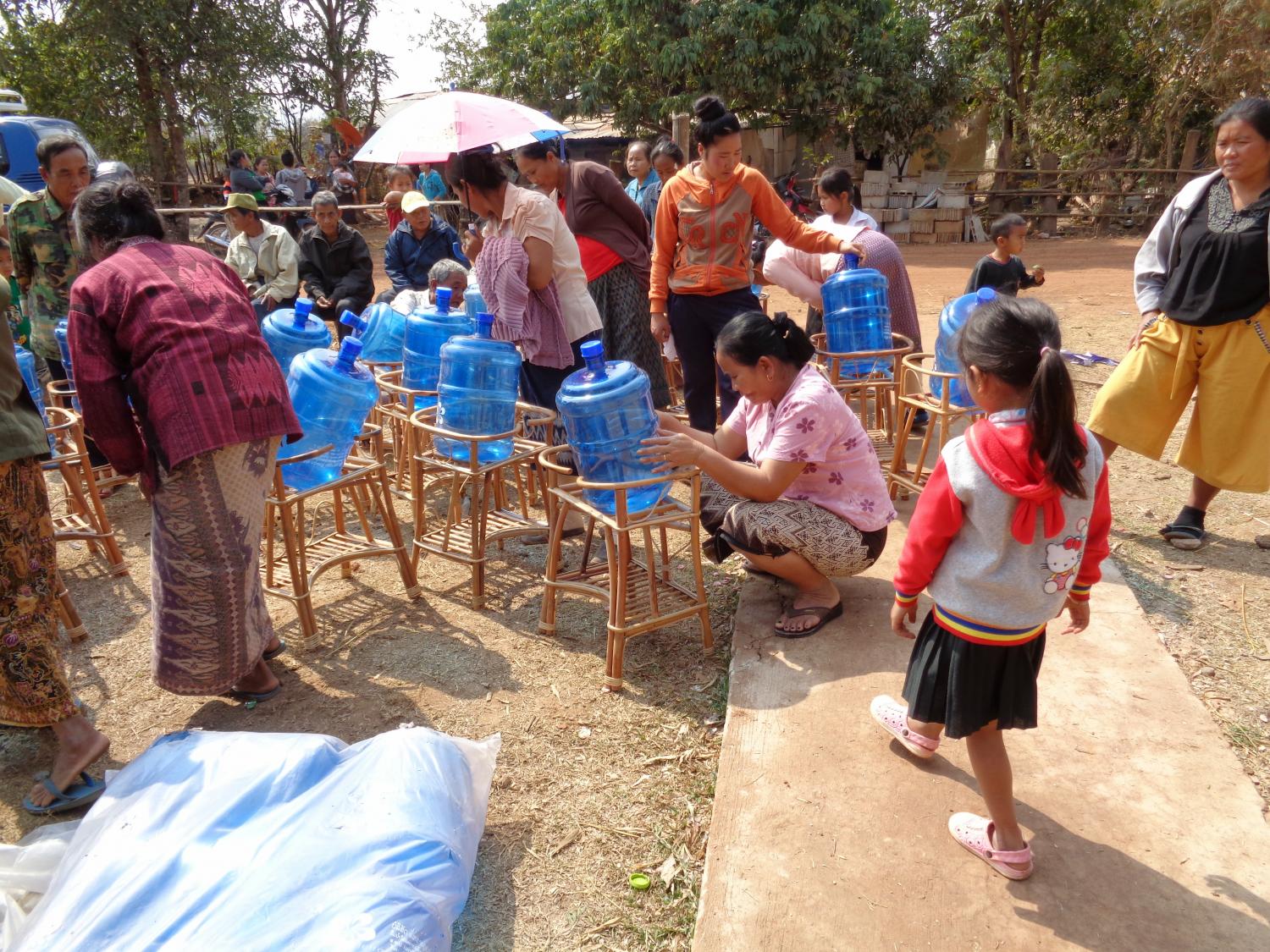 Kiva borrowers carefully select which water filtration unit and stand to take home.
Kiva borrowers carefully select which water filtration unit and stand to take home.Borrowers test the stability and sturdiness of the stands while still paying close attention to their esthetic qualities. They search for the shiniest and most pristine water jugs and tanks, as all resourceful consumers would. Once they have made their choice, they stand by their unit in anticipation of their receipt which is required to take it home. Children come to meet their parents, obviously excited to see the new filters for themselves and proud to know that their house will now have one.
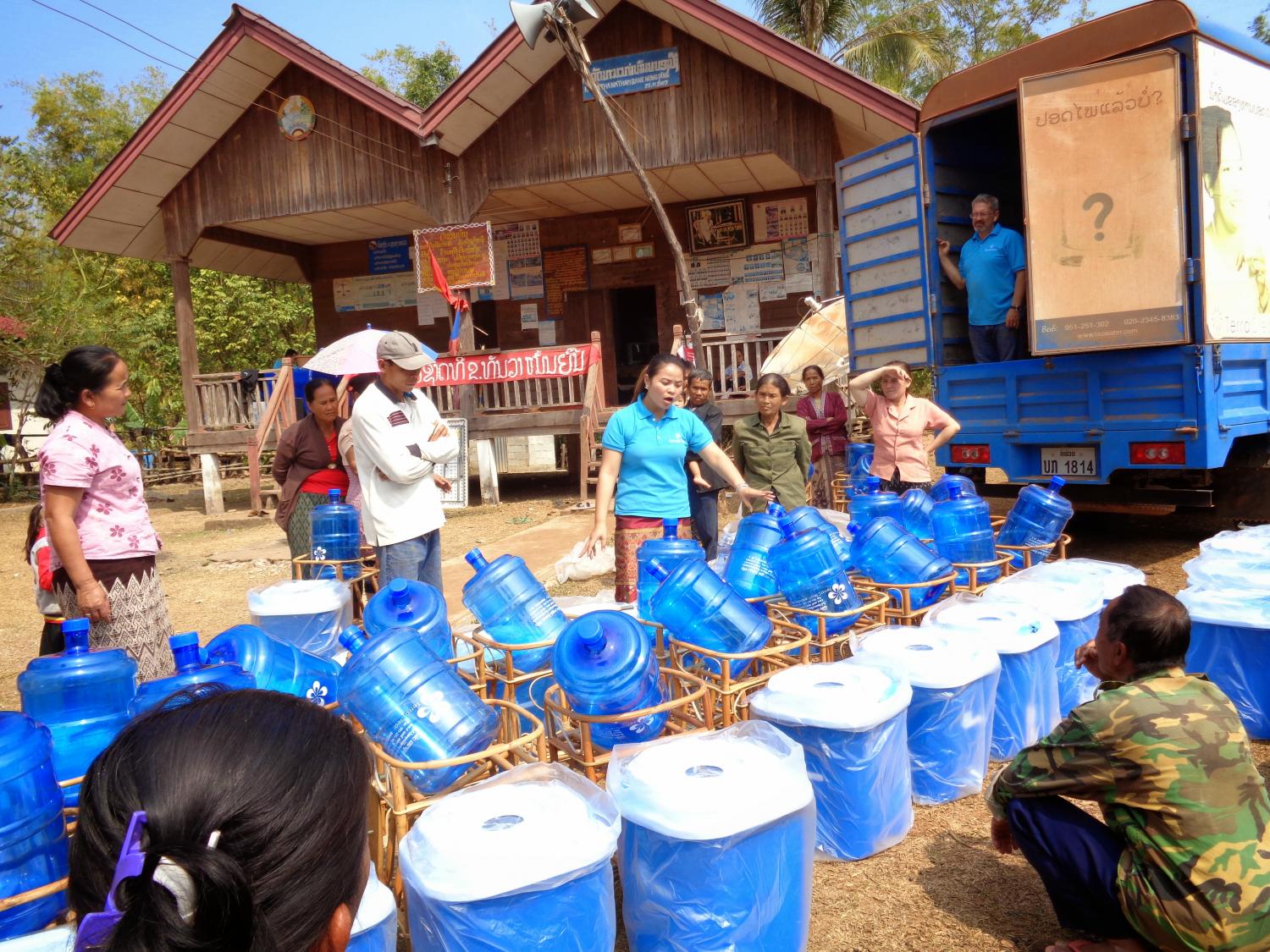 TerraClear water filters all lined up in front of the headman's office.
TerraClear water filters all lined up in front of the headman's office.TerraClear has been doing quite well this year thanks to Kiva funding. A great sales week used to mean that the sales teams were able to sell 20 water filters. Now that figure has grown to an average of 342 water filters per week! With the average Lao household made up of six people, that means each week TerraClear provides clean drinking water to more than 2,000 Lao.
TerraClear is a non-MFI Kiva Field Partner and they are doing great things. If you'd like to help them reach even more people, keep an eye out for their clean water loans here.














